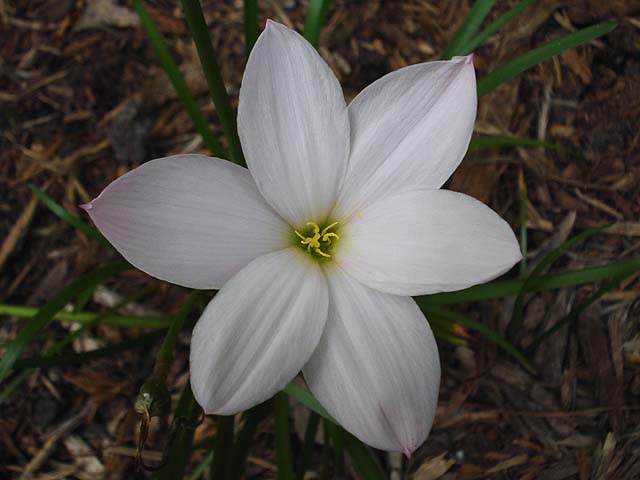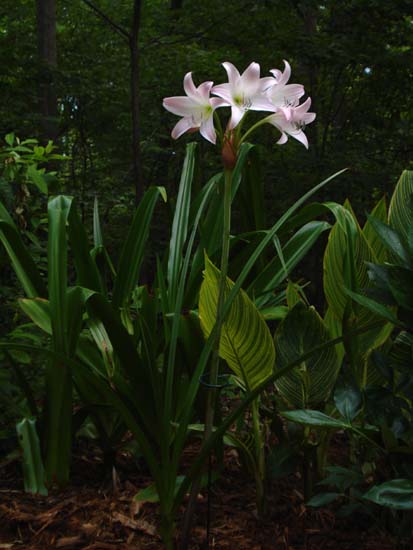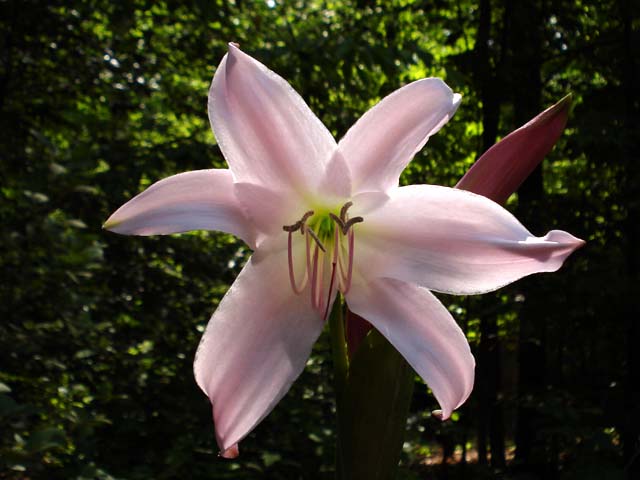While I often try to coax my garden plants, especially the Crinums, into producing new hybrids for me, sometimes the garden just delivers new plants without any help. This post features a new rain lily hybrid I found in the garden. It's a volunteer, rather than the result of one of my more controlled crosses, but I am very pleased with it so far.
Before I get into the details about this plant I'll provide a little bit of general information about rain lilies. They're members of the Amaryllis family (Amaryllidaceae), all native to the Americas, and usually flower in response to rainfall, often within just a few days of a good soaking. These plants are small, but their flowers are relatively large, and if they're planted in quantity they can make quite a show.
The volunteer is a seedling of Zephyranthes 'El Cielo', a rain lily with neat, upright foliage and pink flowers with narrow petals. 'El Cielo' blooms here from April through October, but only rarely does it produce a profusion of flowers, instead a clump will pace itself and deliver them a few at a time over the whole growing season. 'El Cielo' is a good multiplier, forming nice clumps over time, but it's also fertile and will often set seeds.
I suspect that the volunteer's pollen parent is Zephyranthes 'Big Dude', a selection of Z. 'Labuffarosea' and a very different plant than 'El Cielo'. 'Big Dude' has broad and spreading foliage and very large flowers with broad petals that are white with pink tips. It blooms after each rainstorm during July, August, and September, often so heavily that the plants are covered with flowers and the foliage is hidden. Because of this profusion of large flowers, 'Big Dude' is one of my favorite rain lilies. 'Big Dude' is a very good multiplier and rapidly forms large clumps. It will also produce seeds, but appears not to set seed with its own pollen. Despite having good looking foliage during most of the year, one of the drawbacks of all 'Labuffarosea', including 'Big Dude', is a period of semi-dormancy in late spring when their foliage becomes sparse, yellow, and unattractive.
Now that I've introduced the parents it's time to talk about the new baby. Its flowers have similar coloration to 'Big Dude', white with blush pink tips, not as full as 'Big Dude', but much fuller than 'El Cielo'. It got the habit of closing its flowers at night, or in response to the darkening clouds of an approaching thunderstorm, from 'El Cielo'. This is a handy feature, because at least once a summer the flowers of 'Big Dude', which don't close once they've opened, get shredded by a hard rain. Its anthers and stigma are not buried in the floral tube as with 'Big Dude', but they don't stick out of the flower as they do in 'El Cielo'. Its foliage is superior to that of both parents, being broad and frost resistant, but not having an ugly period of semi-dormancy. It's already multiplied into a small clump and it's fertile, setting seeds with its own pollen.
I'll watch this volunteer and if it continues to impress me then I'll be sure to give it a name and share it with other rain lily enthusiasts.
Close-up of Zephyranthes 'El Cielo' × Z. 'Big Dude'

Profile of Zephyranthes 'El Cielo' × Z. 'Big Dude'




































